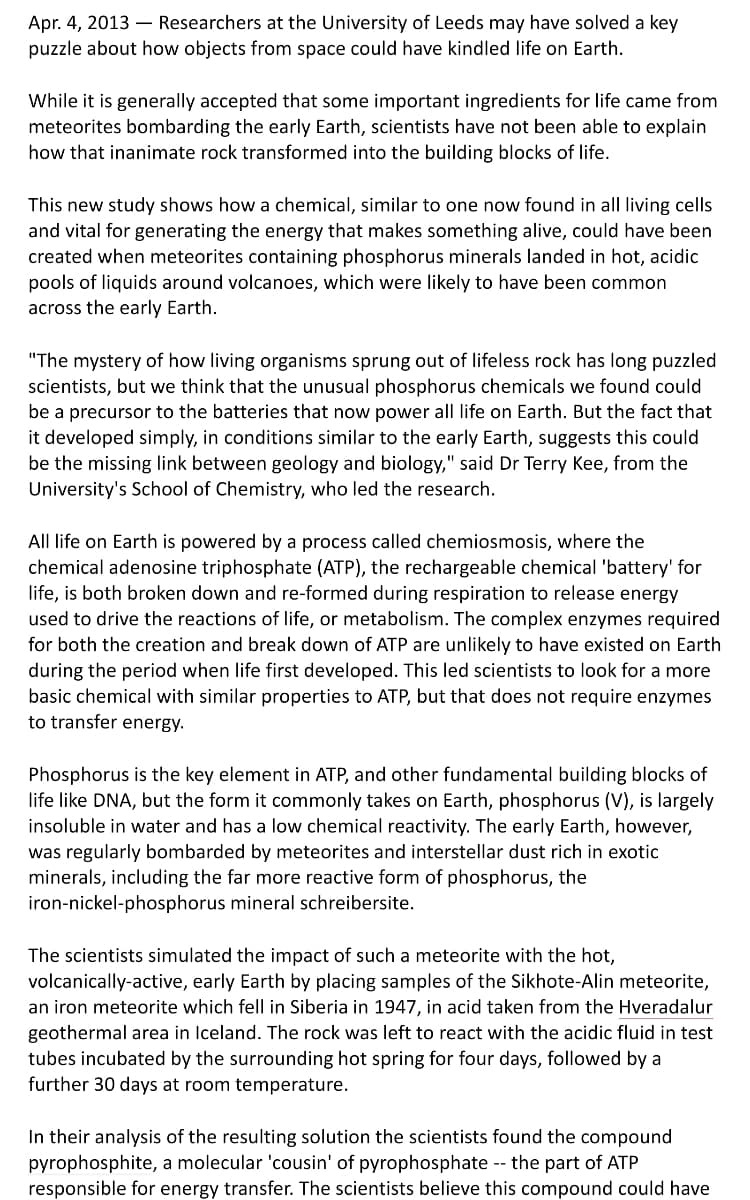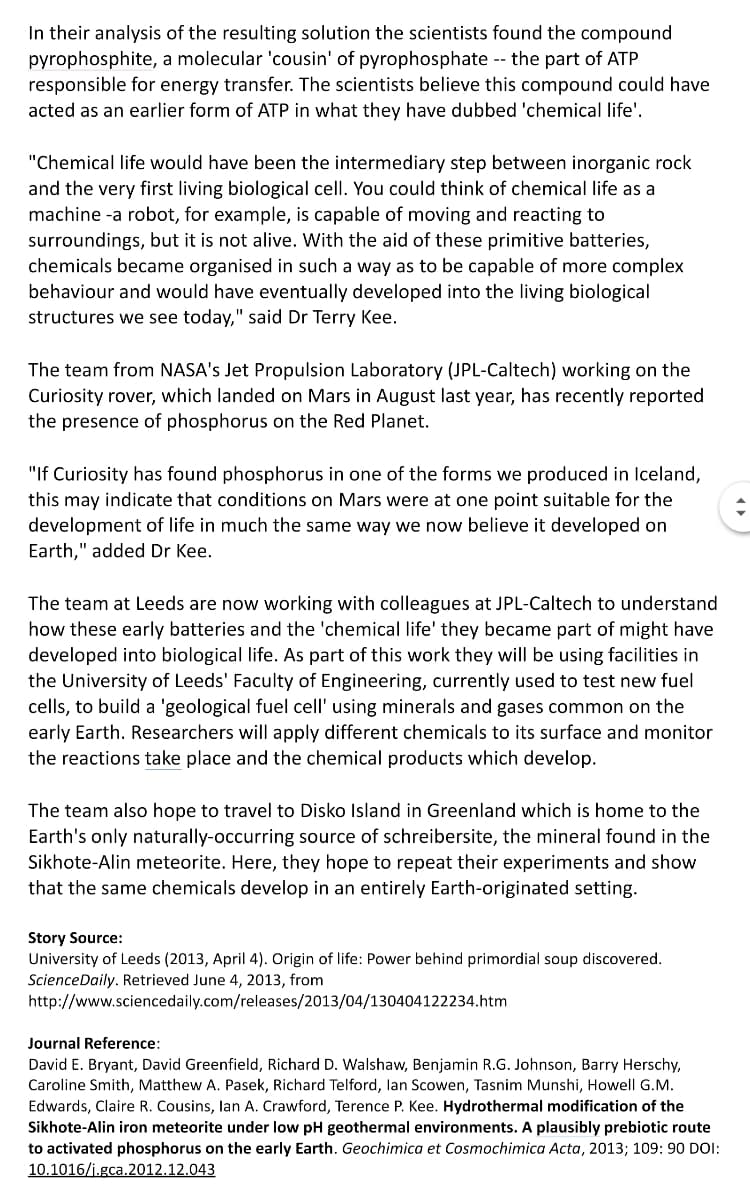Experiments usually have several controlled variables. These are variables that must be kept constant in all parts of an experiment. For example, if an experiment is testing the effect of sunlight on the growth rate of 5 seeds, the only variable that should change should be the amount
Experiments usually have several controlled variables. These are variables that must be kept constant in all parts of an experiment. For example, if an experiment is testing the effect of sunlight on the growth rate of 5 seeds, the only variable that should change should be the amount
Biology Today and Tomorrow without Physiology (MindTap Course List)
5th Edition
ISBN:9781305117396
Author:Cecie Starr, Christine Evers, Lisa Starr
Publisher:Cecie Starr, Christine Evers, Lisa Starr
Chapter13: Early Life Forms And The Viruses
Section: Chapter Questions
Problem 1FIO
Related questions
Question
Experiments usually have several controlled variables. These are variables that must be kept constant in all parts of an experiment. For example, if an experiment is testing the effect of sunlight on the growth rate of 5 seeds, the only variable that should change should be the amount of sunlight. All other variables should remain the same to ensure that sunlight is the only aspect affecting the results. The other variables, such as soil type, amount of water, type/amount of fertilizer, are the controlled variables. Looking back at the simulation experiment on the meteorite, describe two variables that should have been controlled.

Transcribed Image Text:Apr. 4, 2013 – Researchers at the University of Leeds may have solved a key
puzzle about how objects from space could have kindled life on Earth.
While it is generally accepted that some important ingredients for life came from
meteorites bombarding the early Earth, scientists have not been able to explain
how that inanimate rock transformed into the building blocks of life.
This new study shows how a chemical, similar to one now found in all living cells
and vital for generating the energy that makes something alive, could have been
created when meteorites containing phosphorus minerals landed in hot, acidic
pools of liquids around volcanoes, which were likely to have been common
across the early Earth.
"The mystery of how living organisms sprung out of lifeless rock has long puzzled
scientists, but we think that the unusual phosphorus chemicals we found could
be a precursor to the batteries that now power all life on Earth. But the fact that
it developed simply, in conditions similar to the early Earth, suggests this could
be the missing link between geology and biology," said Dr Terry Kee, from the
University's School of Chemistry, who led the research.
All life on Earth is powered by a process called chemiosmosis, where the
chemical adenosine triphosphate (ATP), the rechargeable chemical 'battery' for
life, is both broken down and re-formed during respiration to release energy
used to drive the reactions of life, or metabolism. The complex enzymes required
for both the creation and break down of ATP are unlikely to have existed on Earth
during the period when life first developed. This led scientists to look for a more
basic chemical with similar properties to ATP, but that does not require enzymes
to transfer energy.
Phosphorus is the key element in ATP, and other fundamental building blocks of
life like DNA, but the form it commonly takes on Earth, phosphorus (V), is largely
insoluble in water and has a low chemical reactivity. The early Earth, however,
was regularly bombarded by meteorites and interstellar dust rich in exotic
minerals, including the far more reactive form of phosphorus, the
iron-nickel-phosphorus mineral schreibersite.
The scientists simulated the impact of such a meteorite with the hot,
volcanically-active, early Earth by placing samples of the Sikhote-Alin meteorite,
an iron meteorite which fell in Siberia in 1947, in acid taken from the Hveradalur
geothermal area in Iceland. The rock was left to react with the acidic fluid in test
tubes incubated by the surrounding hot spring for four days, followed by a
further 30 days at room temperature.
In their analysis of the resulting solution the scientists found the compound
pyrophosphite, a molecular 'cousin' of pyrophosphate -- the part of ATP
responsible for energy transfer. The scientists believe this compound could have

Transcribed Image Text:In their analysis of the resulting solution the scientists found the compound
pyrophosphite, a molecular 'cousin' of pyrophosphate -- the part of ATP
responsible for energy transfer. The scientists believe this compound could have
acted as an earlier form of ATP in what they have dubbed 'chemical life'.
"Chemical life would have been the intermediary step between inorganic rock
and the very first living biological cell. You could think of chemical life as a
machine -a robot, for example, is capable of moving and reacting to
surroundings, but it is not alive. With the aid of these primitive batteries,
chemicals became organised in such a way as to be capable of more complex
behaviour and would have eventually developed into the living biological
structures we see today," said Dr Terry Kee.
The team from NASA's Jet Propulsion Laboratory (JPL-Caltech) working on the
Curiosity rover, which landed on Mars in August last year, has recently reported
the presence of phosphorus on the Red Planet.
"If Curiosity has found phosphorus in one of the forms we produced in Iceland,
this may indicate that conditions on Mars were at one point suitable for the
development of life in much the same way we now believe it developed on
Earth," added Dr Kee.
The team at Leeds are now working with colleagues at JPL-Caltech to understand
how these early batteries and the 'chemical life' they became part of might have
developed into biological life. As part of this work they will be using facilities in
the University of Leeds' Faculty of Engineering, currently used to test new fuel
cells, to build a 'geological fuel cell' using minerals and gases common on the
early Earth. Researchers will apply different chemicals to its surface and monitor
the reactions take place and the chemical products which develop.
The team also hope to travel to Disko Island in Greenland which is home to the
Earth's only naturally-occurring source of schreibersite, the mineral found in the
Sikhote-Alin meteorite. Here, they hope to repeat their experiments and show
that the same chemicals develop in an entirely Earth-originated setting.
Story Source:
University of Leeds (2013, April 4). Origin of life: Power behind primordial soup discovered.
ScienceDaily. Retrieved June 4, 2013, from
http://www.sciencedaily.com/releases/2013/04/130404122234.htm
Journal Reference:
David E. Bryant, David Greenfield, Richard D. Walshaw, Benjamin R.G. Johnson, Barry Herschy,
Caroline Smith, Matthew A. Pasek, Richard Telford, lan Scowen, Tasnim Munshi, Howell G.M.
Edwards, Claire R. Cousins, lan A. Crawford, Terence P. Kee. Hydrothermal modification of the
Sikhote-Alin iron meteorite under low pH geothermal environments. A plausibly prebiotic route
to activated phosphorus on the early Earth. Geochimica et Cosmochimica Acta, 2013; 109: 90 DOI:
10.1016/j.gca.2012.12.043
Expert Solution
This question has been solved!
Explore an expertly crafted, step-by-step solution for a thorough understanding of key concepts.
This is a popular solution!
Trending now
This is a popular solution!
Step by step
Solved in 2 steps

Knowledge Booster
Learn more about
Need a deep-dive on the concept behind this application? Look no further. Learn more about this topic, biology and related others by exploring similar questions and additional content below.Recommended textbooks for you

Biology Today and Tomorrow without Physiology (Mi…
Biology
ISBN:
9781305117396
Author:
Cecie Starr, Christine Evers, Lisa Starr
Publisher:
Cengage Learning

Biology: The Dynamic Science (MindTap Course List)
Biology
ISBN:
9781305389892
Author:
Peter J. Russell, Paul E. Hertz, Beverly McMillan
Publisher:
Cengage Learning

Biology (MindTap Course List)
Biology
ISBN:
9781337392938
Author:
Eldra Solomon, Charles Martin, Diana W. Martin, Linda R. Berg
Publisher:
Cengage Learning

Biology Today and Tomorrow without Physiology (Mi…
Biology
ISBN:
9781305117396
Author:
Cecie Starr, Christine Evers, Lisa Starr
Publisher:
Cengage Learning

Biology: The Dynamic Science (MindTap Course List)
Biology
ISBN:
9781305389892
Author:
Peter J. Russell, Paul E. Hertz, Beverly McMillan
Publisher:
Cengage Learning

Biology (MindTap Course List)
Biology
ISBN:
9781337392938
Author:
Eldra Solomon, Charles Martin, Diana W. Martin, Linda R. Berg
Publisher:
Cengage Learning